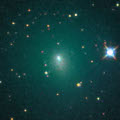
|
Brightening rapidly. Now it is 6.8 mag (Oct. 2, Toni Scarmato). This apparition is best condition. It will approach to the earth down to 0.12 A.U. in October, and brighten up to 5 mag. It will be visible with naked eyes. In the Northern Hemisphere, it keeps observable all through this apparition until 2011 June when it fades down to 17 mag. In the Southern Hemisphere, it becomes unobservable temporarily from late September to mid October. But then it keeps observable in good condition.
Date(TT) R.A. (2000) Decl. Delta r Elong. m1 Best Time(A, h)
Oct. 2 0 52.13 55 30.3 0.179 1.119 127 6.8 0:07 (180, 70)
Oct. 9 2 28.99 56 29.5 0.146 1.092 126 6.0 1:15 (180, 68)
|
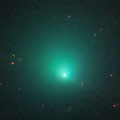
|
It has been keeping bright as 8.5 mag since July. It is bright as 8.5 mag still now (Sept. 20, Juan Jose Gonzalez). It will be fading after this, but it will be visible visually until December.
Date(TT) R.A. (2000) Decl. Delta r Elong. m1 Best Time(A, h)
Oct. 2 1 28.46 -20 4.1 0.737 1.690 152 10.6 0:48 ( 0, 35)
Oct. 9 1 23.02 -20 13.0 0.777 1.728 152 10.9 0:15 ( 0, 35)
|
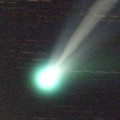
|
Paul Camilleri reported that it was not visible, fainter than 14-15 mag, on Sept. 29. It was expected to be bright as 11 mag, but it seems to have faded rapidly. It passed the perihelion in July and brightened up to 5 mag. Hirohisa Sato reported that it was clearly visible in the SWAN images in August. It kept visible in the SWAN images until Sept. 6. However, it may have been disintegrated after that. It is observable in the Southern Hemisphere after this. In the Northern Hemisphere, it will never be observable again.
Date(TT) R.A. (2000) Decl. Delta r Elong. m1 Best Time(A, h)
Oct. 2 10 46.18 -45 30.7 2.427 1.908 47 11.8 4:31 (312,-20)
Oct. 9 10 57.58 -49 11.1 2.509 2.017 49 12.2 4:36 (318,-19)
|
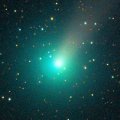
|
It brightened up to 7.9 mag in April and May (May 5, Juan Jose Gonzalez). Now it is fading. But it is still bright as 10.9 mag (Sept. 17, Jakub Cerny). It keeps observable for a long time until when it fades out in the Northern Hemisphere. It will be visible visually until December. It is not observable in the Southern Hemisphere.
Date(TT) R.A. (2000) Decl. Delta r Elong. m1 Best Time(A, h)
Oct. 2 8 6.22 50 52.2 2.541 2.530 78 12.3 4:31 (229, 55)
Oct. 9 7 59.69 50 55.6 2.491 2.601 84 12.5 4:36 (226, 61)
|
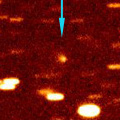
|
The condition of this apparition is bad. It has not been observable at all around the maximum brightness. However, it is appearing in the morning sky now. Now it is 13.0 mag (Sept. 25, Ken-ichi Kadota). It keeps observable after this while fading gradually.
Date(TT) R.A. (2000) Decl. Delta r Elong. m1 Best Time(A, h)
Oct. 2 10 30.25 -1 46.3 2.481 1.694 30 13.4 4:31 (278, 8)
Oct. 9 10 45.84 -3 47.6 2.492 1.737 32 13.6 4:36 (282, 10)
|
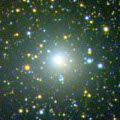
|
It reached up to 7.7 mag in last summer (2009 Aug. 13, Chris Wyatt). It is fading now. It has already faded down to 13.2 mag (Sept. 6, Chris Wyatt). In the Southern Hemisphere, it keeps observable for a long time after this. In the Northern Hemisphere, it will never be observable again.
Date(TT) R.A. (2000) Decl. Delta r Elong. m1 Best Time(A, h)
Oct. 2 17 13.40 -47 7.8 5.383 5.203 74 13.7 19:07 ( 26, 1)
Oct. 9 17 14.13 -47 5.6 5.538 5.250 68 13.8 18:57 ( 28, -1)
|

|
Already bright as 12.8 mag and visible visually (Aug. 20, Juan Jose Gonzalez). It is expected to keep so bright as 6-8 mag for a long time from 2011 to 2012, and to be observable in good condition in the Northern Hemisphere. In 2010, it is observable in good condition in the Southern Hemisphere while brightening slowly. It locates low in the Northern Hemisphere, but it keeps observable until the end of 2010.
Date(TT) R.A. (2000) Decl. Delta r Elong. m1 Best Time(A, h)
Oct. 2 22 32.65 -37 57.9 4.618 5.321 130 13.8 21:48 ( 0, 17)
Oct. 9 22 25.12 -37 36.6 4.637 5.259 123 13.8 21:13 ( 0, 17)
|
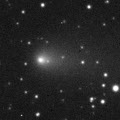
|
Now it is 12.7 mag (Sept. 10, Artyom Novichonok). It will keep 12-13 mag until autumn. It is observable in excellent condition in the Southern Hemisphere. It locates somewhat low in the Northern Hemisphere.
Date(TT) R.A. (2000) Decl. Delta r Elong. m1 Best Time(A, h)
Oct. 2 20 37.27 -31 38.4 2.189 2.757 114 13.8 19:53 ( 0, 23)
Oct. 9 20 40.95 -31 0.9 2.291 2.776 108 13.9 19:30 ( 0, 24)
|

|
It is appearing in the morning sky again.
Date(TT) R.A. (2000) Decl. Delta r Elong. m1 Best Time(A, h)
Oct. 2 10 43.68 4 27.3 7.098 6.233 28 14.2 4:31 (271, 8)
Oct. 9 10 48.03 3 55.2 7.040 6.234 33 14.2 4:36 (275, 14)
|
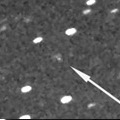
|
The condition in this apparition is bad. It keeps unobservable for a while. In the Southern Hemisphere, it will appear in the morning sky at 12.5 mag in February, then it keeps observable while fading gradually. In the Northern Hemisphere, it is not observable until when it fades down to 15 mag.
Date(TT) R.A. (2000) Decl. Delta r Elong. m1 Best Time(A, h)
Oct. 2 12 42.29 1 49.6 2.802 1.809 5 14.7 19:07 (101,-13)
Oct. 9 12 58.74 -0 10.3 2.765 1.775 5 14.4 18:57 (100,-14)
|

|
Observable in the evening sky in the Southern Hemisphere. Fading rapidly. It was bright as 7.7 mag on Aug. 17 (Chris Wyatt), but it has already faded down to 12.8 mag now (Sept. 27, Artyom Novichonok). It will keep observable while fading rapidly after this in the Southern Hemisphere. It is not observable in the Northern Hemisphere.
Date(TT) R.A. (2000) Decl. Delta r Elong. m1 Best Time(A, h)
Oct. 2 16 2.78 -28 9.1 1.461 1.225 55 14.5 19:07 ( 48, 7)
Oct. 9 16 35.63 -28 58.4 1.589 1.328 56 15.2 18:57 ( 45, 9)
|
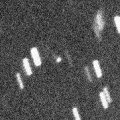
|
Now it is 14.6 mag, much brighter than originally expected (Sept. 1, Artyom Novichonok, Leonid Elenin). It keeps observable in good condition from autumn to next spring. It will brighten up to 13 mag and will be visible visually.
Date(TT) R.A. (2000) Decl. Delta r Elong. m1 Best Time(A, h)
Oct. 2 7 49.25 22 50.2 3.343 3.206 73 14.7 4:31 (279, 54)
Oct. 9 7 49.16 21 16.9 3.194 3.179 80 14.6 4:36 (289, 60)
|
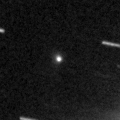
|
Now it is 14.0 mag, much brighter than expected and visible visually (Sept. 10, Alan Hale). In the Northern Hemisphere, it will be observable at 14-15 mag in good condition from autumn to winter. In the Southern Hemisphere, it will be unobservable until 2011 spring.
Date(TT) R.A. (2000) Decl. Delta r Elong. m1 Best Time(A, h)
Oct. 2 14 8.48 72 6.4 2.873 2.823 77 14.8 19:07 (158, 35)
Oct. 9 14 54.33 71 41.4 2.783 2.791 80 14.6 18:57 (157, 37)
|
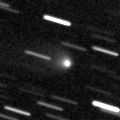
|
It is already bright as 13.8 mag and visible visually (Sept. 10, Chris Wyatt). It will be observable at 13-14 mag for a long time from 2011 to 2012.
Date(TT) R.A. (2000) Decl. Delta r Elong. m1 Best Time(A, h)
Oct. 2 20 22.61 -3 52.7 6.095 6.616 117 15.1 19:38 ( 0, 51)
Oct. 9 20 18.85 -4 22.9 6.178 6.584 109 15.1 19:07 ( 0, 51)
|
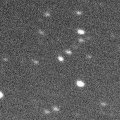
|
Now it is 14.8 mag (June 23, Hidetaka Sato). It keeps bright as 14-15 mag for a long time after this until 2013. It is observable in good condition in the Southern Hemisphere. However, it is not observable in the Northern Hemisphere. It must be bright, however, no observations have been reported since early July.
Date(TT) R.A. (2000) Decl. Delta r Elong. m1 Best Time(A, h)
Oct. 2 14 37.62 -48 57.6 6.936 6.383 52 15.3 19:07 ( 43,-19)
Oct. 9 14 41.89 -49 23.5 6.973 6.357 48 15.2 18:57 ( 44,-21)
|
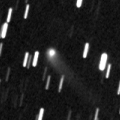
|
Now it is bright as 14.2 mag and visible visually (Sept. 5, Sandor Szabo). It keeps observable at 14-15 mag for a long time in 2010. It locates in good condition in the Northern Hemisphere. It locates low, and will be unobservable in October in the Southern Hemisphere.
Date(TT) R.A. (2000) Decl. Delta r Elong. m1 Best Time(A, h)
Oct. 2 17 45.84 36 12.1 4.525 4.511 82 15.3 19:07 (102, 65)
Oct. 9 17 51.83 35 30.9 4.568 4.512 80 15.3 18:57 (101, 62)
|
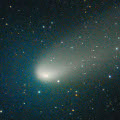
|
It reached up to 9.2 mag in March (Mar. 20, Marco Goiato). Now it is fading. It has already faded down to 14.8 mag (Sept. 1, Hidetaka Sato). It will be getting lower in the evening sky, and will be unobservable in November.
Date(TT) R.A. (2000) Decl. Delta r Elong. m1 Best Time(A, h)
Oct. 2 16 40.61 -20 8.5 2.846 2.551 62 15.6 19:07 ( 47, 19)
Oct. 9 16 52.53 -20 36.2 2.964 2.592 58 15.7 18:57 ( 48, 18)
|
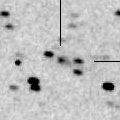
|
Recovered as bright as expected. Now it is 15.7 mag (Sept. 18, Jean-Francois Soulier). It is observable at 15.5 mag in good condition from autumn to winter. It locates somewhat low in the Southern Hemisphere.
Date(TT) R.A. (2000) Decl. Delta r Elong. m1 Best Time(A, h)
Oct. 2 6 20.58 19 10.5 1.810 2.124 93 16.2 4:31 (312, 68)
Oct. 9 6 29.70 20 12.0 1.733 2.124 98 16.1 4:36 (324, 72)
|

|
It keeps 16 mag until the end of 2010. It keeps observable in good condition in the Southern Hemisphere. But it is not observable at all in the Northern Hemisphere. It must have been bright, but no observations have been reported since May.
Date(TT) R.A. (2000) Decl. Delta r Elong. m1 Best Time(A, h)
Oct. 2 8 28.35 -57 28.1 2.881 2.739 71 16.2 4:31 (336,-11)
Oct. 9 8 24.58 -61 7.9 2.835 2.738 74 16.1 4:36 (342,-11)
|
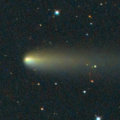
|
It brightened up to 9.5 mag in January (Jan. 13, Juan Jose Gonzalez). Now it is fading. It has already faded down to 15.4 mag (Sept. 9, Katsumi Yoshimoto). It will be fainter than 18 mag at the end of 2010. In the Northern Hemisphere, it keeps observable for a long time, although it will be getting lower gradually. It is not observable in the Southern Hemisphere.
Date(TT) R.A. (2000) Decl. Delta r Elong. m1 Best Time(A, h)
Oct. 2 16 0.05 38 55.9 4.764 4.417 63 16.3 19:07 (113, 45)
Oct. 9 16 8.65 37 51.4 4.846 4.474 62 16.4 18:57 (112, 43)
|
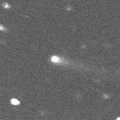
|
It was observed at 16 mag from late 2009 to early 2010. It has already passed the perihelion, however, it tends to be brightest after the perihelion passage. It will be observable at 16 mag again in good condition from late 2010 to early 2011.
Date(TT) R.A. (2000) Decl. Delta r Elong. m1 Best Time(A, h)
Oct. 2 9 36.54 13 22.4 4.030 3.419 46 16.4 4:31 (272, 27)
Oct. 9 9 44.50 12 38.0 3.967 3.432 51 16.3 4:36 (277, 32)
|

|
Now it is 16.8 mag (July 21, Hidetaka Sato). It keeps 16.5 mag until 2011 spring. It keeps observable in good condition in the Southern Hemisphere. But in the Northern Hemisphere, it locates very low in 2011 spring only.
Date(TT) R.A. (2000) Decl. Delta r Elong. m1 Best Time(A, h)
Oct. 2 11 33.76 -56 29.4 3.333 2.867 54 16.7 4:31 (320,-31)
Oct. 9 11 34.75 -57 1.8 3.338 2.858 53 16.7 4:36 (322,-27)
|

|
Now it is 16.9 mag (Sept. 25, K. Cernis, J. Zdanavicius). It will pass the perihelion on Nov. 25. In the Northern Hemisphere, it is observable until early November when it brightens up to 16 mag, and after mid December while fading from 16 mag. It will not be observable in the Southern Hemisphere.
Date(TT) R.A. (2000) Decl. Delta r Elong. m1 Best Time(A, h)
Oct. 2 8 25.37 23 8.7 1.262 1.244 65 17.1 4:31 (273, 47)
Oct. 9 8 55.68 20 25.4 1.123 1.143 64 16.8 4:36 (276, 46)
|
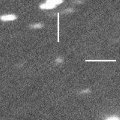
|
Now it is 17.4 mag (Sept. 3, La Sagra). It keeps 17 mag for a long time from 2009 to 2012. It is observable in good condition in the Northern Hemisphere. It locates somewhat low in the Southern Hemisphere.
Date(TT) R.A. (2000) Decl. Delta r Elong. m1 Best Time(A, h)
Oct. 2 1 55.81 20 29.2 7.252 8.159 153 16.9 1:15 ( 0, 76)
Oct. 9 1 50.18 20 10.7 7.200 8.151 160 16.9 0:42 ( 0, 75)
|

|
Now it is 17.4 mag (Aug. 16, Ken-ichi Kadota). It has already passed the perihelion, however, it tends to be brightest after the perihelion passage. In the Northern Hemisphere, it will be observable at 17.5 mag in good condition until the end of 2010. It locates extremely low in the Southern Hemisphere.
Date(TT) R.A. (2000) Decl. Delta r Elong. m1 Best Time(A, h)
Oct. 2 8 18.26 31 17.8 2.182 2.054 69 17.4 4:31 (262, 51)
Oct. 9 8 30.98 30 10.2 2.135 2.079 73 17.4 4:36 (266, 55)
|

|
Now it is 17.3 mag (Oct. 2, Toru Yusa). It is observable at 17.5 mag in good condition from summer to autumn in the Northern Hemisphere. It locates somewhat low in the Southern Hemisphere.
Date(TT) R.A. (2000) Decl. Delta r Elong. m1 Best Time(A, h)
Oct. 2 1 2.13 34 21.5 0.915 1.843 148 17.5 0:21 ( 0, 89)
Oct. 9 1 0.58 33 6.0 0.905 1.852 152 17.5 23:48 ( 0, 88)
|

|
Now it is 17.4 mag (Sept. 28, A. Novichonok, V. Gerke). It is expected to be 15 mag and will be observable in good condition in 2013. It is observable in good condition in the Northern Hemisphere, but not observable in the Southern Hemisphere now.
Date(TT) R.A. (2000) Decl. Delta r Elong. m1 Best Time(A, h)
Oct. 2 3 31.79 60 38.5 8.332 8.778 113 17.5 2:51 (180, 64)
Oct. 9 3 24.63 61 4.0 8.223 8.744 118 17.5 2:16 (180, 64)
|

|
Now it is 16.9 mag (Aug. 11, Ken-ichi Kadota). Now it is fading. It will be fainter than 18 mag in November. It locates in excellent condition in the Southern Hemisphere, but it locates low in the Northern Hemisphere.
Date(TT) R.A. (2000) Decl. Delta r Elong. m1 Best Time(A, h)
Oct. 2 20 32.30 -33 0.3 2.728 3.252 112 17.5 19:48 ( 0, 22)
Oct. 9 20 34.77 -32 33.2 2.823 3.256 106 17.6 19:23 ( 0, 23)
|

|
It has not been observed in this apparition yet, but it must have been already bright as 17-18 mag. Now it locates in very good condition in the Southern Hemisphere. But it will be getting lower after this, and will be unobservable in January. In the Northern Hemisphere, it will be observable in good condition while fading gradually from 16 mag after 2011 summer.
Date(TT) R.A. (2000) Decl. Delta r Elong. m1 Best Time(A, h)
Oct. 2 20 9.91 -35 42.0 2.237 2.714 107 17.6 19:26 ( 0, 19)
Oct. 9 20 12.15 -35 20.4 2.288 2.674 101 17.6 19:01 ( 0, 20)
|

|
Peculiar asteroid moving along a comet-like retrograde orbit. It brightens up to 16.5 mag in November. It is observable in excellent condition in the Southern Hemisphere. In the Northern Hemisphere, it will become lower rapidly, and will locate extremely low in November.
Date(TT) R.A. (2000) Decl. Delta r Elong. m1 Best Time(A, h)
Oct. 2 6 37.49 -5 15.7 1.831 2.059 88 18.2 4:31 (329, 45)
Oct. 9 6 29.02 -9 12.0 1.642 2.007 95 17.9 4:36 (345, 45)
|
|
![]()
 65P/Gunn
65P/Gunn 29P/Schwassmann-Wachmann 1
29P/Schwassmann-Wachmann 1 9P/Tempel 1
9P/Tempel 1 2P/Encke
2P/Encke C/2010 B1 ( Cardinal )
C/2010 B1 ( Cardinal ) C/2009 Y1 ( Catalina )
C/2009 Y1 ( Catalina ) C/2006 S3 ( LONEOS )
C/2006 S3 ( LONEOS ) C/2009 F4 ( McNaught )
C/2009 F4 ( McNaught ) C/2008 FK75 ( Lemmon-Siding Spring )
C/2008 FK75 ( Lemmon-Siding Spring ) 81P/Wild 2
81P/Wild 2 240P/2010 P1 ( NEAT )
240P/2010 P1 ( NEAT ) C/2010 A4 ( Siding Spring )
C/2010 A4 ( Siding Spring ) C/2007 Q3 ( Siding Spring )
C/2007 Q3 ( Siding Spring ) 203P/2008 R4 ( Korlevic )
203P/2008 R4 ( Korlevic ) C/2010 FB87 ( WISE-Garradd )
C/2010 FB87 ( WISE-Garradd ) (3200) Phaethon
(3200) Phaethon C/2008 S3 ( Boattini )
C/2008 S3 ( Boattini ) 241P/2010 P2 ( LINEAR )
241P/2010 P2 ( LINEAR ) 236P/2010 K1 ( LINEAR )
236P/2010 K1 ( LINEAR ) C/2010 S1 ( LINEAR )
C/2010 S1 ( LINEAR ) 215P/2009 B5 ( NEAT )
215P/2009 B5 ( NEAT ) 164P/Christensen
164P/Christensen 2009 YS6
2009 YS6![]()




















